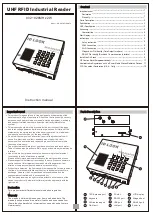
Chapter 5
Chapter 5
Chapter 5
Chapter 5
Chapter 5
Software
27
Parameter Descriptions
param[0]
param[0]
param[0]
param[0]
param[0]
0
=
Specify
Number
one
Card.
1
=
Specify
Number
two
Card.
The
software
driver
supports
up
to
two
PC-LabCards
at
one
time.
Set
Param[0]
to
tell
the driver
which
card
is
specified.
param[1]
param[1]
param[1]
param[1]
param[1]
PC-LabCard
I/O
address
can
be
anywhere
from
200
(Hex)
to
3F0
(Hex).
The
base
address
can
be
set
to
200
or
210,
230
or
240
....
3F0.
param[10]
param[10]
param[10]
param[10]
param[10]
Offset
address
for
A/D
data
buffer
A.
param[11]
param[11]
param[11]
param[11]
param[11]
Segment
address
for
A/D
data
buffer
A.
param[12]
param[12]
param[12]
param[12]
param[12]
Offset
address
for
A/D
data
buffer
B.
param[13]
param[13]
param[13]
param[13]
param[13]
Segment
address
for
A/D
data
buffer
B.
NOTE:
NOTE:
NOTE:
NOTE:
NOTE:
For
C
or
PASCAL,
use
their
built-in
memory
allocation
functions
to
allocate
sufficient
memory
for
buffers
A
and
B.
These
memory
allocation
functions
will
return
the
offset
and
segment
addresses.
Save
them
to
Param[10]
through
Param[13].
If
buffer
B
is
not
used,
be
sure
that
you
set
Param[12]
and
Param[13]
to
0.
Because
BASICA
and
Quick
BASIC
do
not
provide
memory
alloca-
tion
functions,
you
will
have
to
assign
explicit
segment
addresses
for
each
buffer.
If
you
assign
a
segment
address
as
0,
then
the
driver
will
use
the
current
data
segment
(DS)
for
buffers
A
and
B.
If
buffer
B
is
not
used,
be
sure
that
you
set
Param[12] and Param[13] to 0.
param[14]
param[14]
param[14]
param[14]
param[14]
This parameter sets the A/D conversion number. The
range is from 1 to 32767.
param[15]
param[15]
param[15]
param[15]
param[15]
Sets the A/D start channel number.
Artisan Technology Group - Quality Instrumentation ... Guaranteed | (888) 88-SOURCE | www.artisantg.com
















































